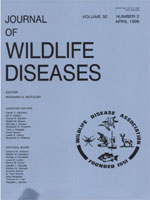Small mammals were captured in a Costa Rican dairy farm located in a vesicular stomatitis virus (VSV) enzootic focus, in order to determine which species were naturally infected by this virus. Monthly captures were performed from March 1989 to February 1990. Eighty-four individuals belonging to the orders Rodentia (n = 52), Insectivora (n = 31) and Marsupialia (n = 1) were captured. Only Sigmodon hispidus had neutralizing antibodies to VSV; among 21 animals, six had antibodies to Indiana, one to New Jersey, and two to both serotypes. In addition, groups of 40 sentinel mice (Mus musculus, strain C3H) were placed in cages distributed throughout the farm. Each group was exposed for 1 mo over a period of 1 yr. None of 312 sentinel mice developed antibodies against either VSV serotype. Based on these results, we believe that S. hispidus might be part of the natural cycle of VSV in this enzootic focus. Caged Mus musculus do not seem appropriate for monitoring VSV activity in this area.
How to translate text using browser tools
1 April 1996
SEROLOGICAL SURVEY OF SMALL MAMMALS IN A VESICULAR STOMATITIS VIRUS ENZOOTIC AREA
Ana E. Jiménez,
Carlos Jiménez,
Leda Castro,
Luis Rodríguez

Journal of Wildlife Diseases
Vol. 32 • No. 2
April 1996
Vol. 32 • No. 2
April 1996
natural cycle
serologic survey
Sigmodon hispidus
small mammals
vesicular stomatitis virus




